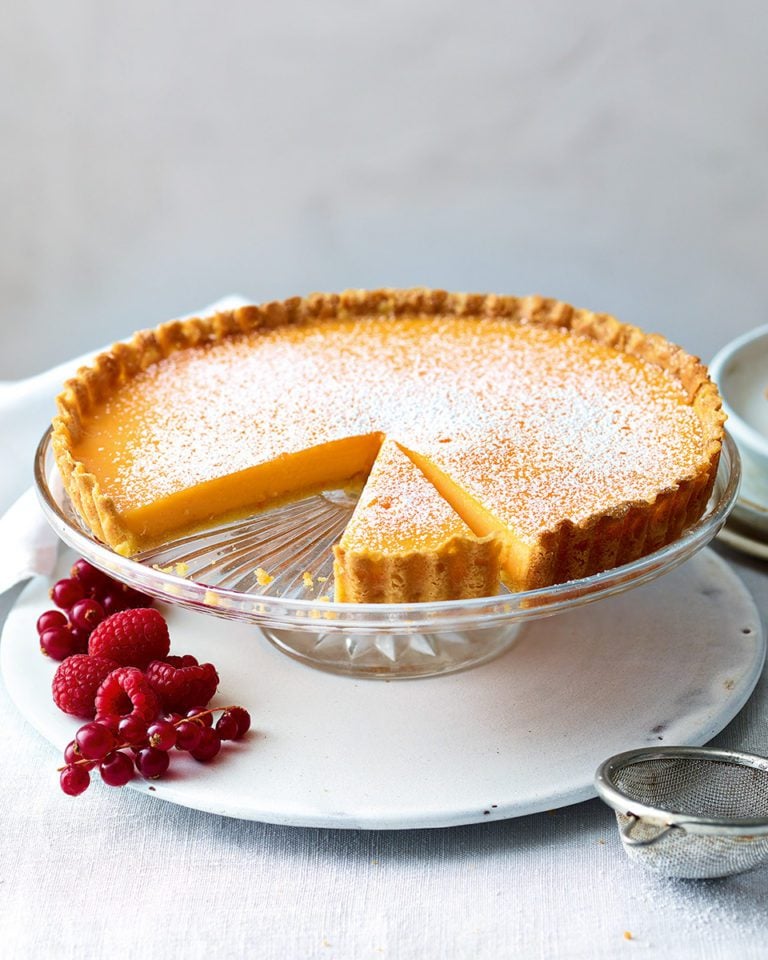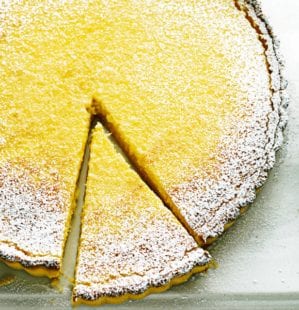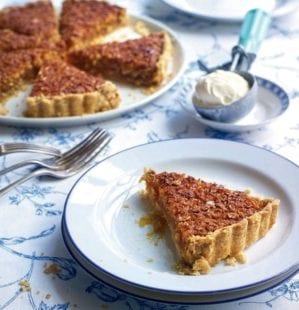
Michel Roux Jr’s classic lemon tart
- Published: 4 Jun 22
- Updated: 25 Mar 24
Make a perfect lemon tart with Michel Roux Jr’s recipe. The top chef’s tips and tricks will help you master tarte fine au citron, a classic French dessert.

Browse more tried and tested patisserie recipes, including tarte aux pommes and homemade croissants.
Michel Roux Jr began his career with a patisserie apprenticeship in Paris. For nearly 30 years he’s been chef-patron of two-Michelin-star restaurant Le Gavroche, opened in 1967 by his late father Albert and uncle Michel Sr. He also oversees the food at London hotel The Langham and teaches at its cookery school, Sauce by The Langham. Michel Roux Jr’s classes are a chance to learn from the main man, while preparing a menu of his design.
-
Serves 8
-
Hands-on time 40 min, plus chilling, resting and at least 4 hours cooling. Oven time 1 hour 15-25 min
Ingredients
For the pâte sablée
- 125g plain flour, sifted
- 100g unsalted butter, cut into small pieces and slightly softened, plus extra to grease
- 100g icing sugar, sifted, plus extra to dust
- 3 medium egg yolks (see Don’t Waste It)
- 1 tsp whole milk
For the filling
- 5 medium free-range eggs
- 180g caster sugar
- 150ml double cream
- Finely grated zest and strained juice of 2 lemons
You’ll also need
- 22cm tart tin, about 2cm deep (see Know How)
Method
- To make the pâte sablée, heap the flour in a mound on the work surface and make a well in the centre. Put the butter, icing sugar and a pinch of salt into the well. With your fingertips, mix the butter into the sugar and salt, then add 2 egg yolks and delicately work them in with your fingertips. Little by little, draw the flour into the centre and delicately work the mixture with your fingers until you have an evenly mixed dough. Using the palm of your hand, push the dough away from you 3 or 4 times until it’s completely smooth. Roll it into a ball, wrap well and chill until ready to use (see Make Ahead).
- Lightly butter the tart tin and chill on a baking tray. Roll out the pastry to a circle 3-4mm thick. Drape it over the rolling pin and unfurl over the tin. Line the tin with the pastry, gently tapping it into place with a knob of the pastry. Trim off the excess pastry then, using your index finger and thumb, gently press the pastry edges up the side of the tin to form a lip that extends about 2mm. Chill for 20 minutes until firm (see Make Ahead).
- Heat the oven to 170°C fan/gas 5. Line the base of the chilled pastry case with baking paper, fill with baking beans and bake blind for 15 minutes. Remove the beans and paper. Mix the remaining egg yolk with the milk, then brush the base and sides of the pastry with the egg glaze. Bake for a further 10 minutes until the pastry is light golden. Take out and lower the temperature to 110°C fan/gas ¾.
- For the filling, lightly whisk the eggs and sugar in a bowl until combined, without letting the mixture turn pale or become too aerated (see Roux’s Rules in tips). Add the cream, lemon zest and juice, stir briefly to combine, then cover and chill until ready to use.
- Lightly whisk the chilled lemon filling, then pour it into the tart case up to the level of the lip. Immediately bake the tart for 50-60 minutes until set (see Roux’s Rules). Leave for about 5 minutes, then carefully remove the tart from the tin and cool on a wire rack for at least 4 hours before serving. Serve the tart generously dusted with icing sugar. It’s great accompanied by red berries when in season.
- Recipe from April 2022 Issue
Nutrition
- Calories
- 459kcals
- Fat
- 26.1g (14.4g saturated)
- Protein
- 7.9g
- Carbohydrates
- 47.6g (35.5g sugars)
- Fibre
- 0.6g
- Salt
- 0.2g
FAQs
Why cream the butter and sugar together?
It makes the pastry biscuit-like and more indulgent.
Can I use caster sugar?
Icing sugar mixes better with the butter and makes the pastry hold better.
Why make the pastry by hand?
It’s tactile: you can feel when it’s ready. It should be smooth and come together completely, without any bits of butter or egg yolk that haven’t been incorporated. It can be an issue if your hands are hot, as this can make the pastry melt and stick. But if you make it in a food processor, it’s easy to overwork it and the pastry will be akin to cardboard, as opposed to crumbly and soft.
Do I need to chill the pastry?
Yes, for two reasons: it sets the butter a little to make it easier to roll out, and it allows the glutens in the flour, which have been stretched by working it, to rest.
How do I avoid shrinkage?
This normally occurs when the pastry’s been overworked. To overcome that shrinkage you can line the tart tin over the rim, then trim it after it’s cooked, as opposed to trimming before you cook. When blind baking and using baking beans, make sure they go all the way up to the edge to hold the pastry.
Why only whisk the filling mixture briefly?
If you over-whisk it you get a froth, then when you cook it, it separates. Your lemon tart should be uniform and yellow.
Should the cooked tart still have a wobble in the middle?
No, it has to be set. Unlike a cheesecake or flan, it doesn’t continue cooking. You have to catch it at the point where it’s cooked all the way through but not overcooked (or it will crack). Follow the recipe, but remember that not all ovens are the same. Look at the tart and give it a tiny wobble to see how the filling moves in the case.
Should I wait before serving?
Yes. Don’t even try to cut the tart when it’s warm. It needs to set. At the restaurant we normally make the tarts in the morning, ready to be served in the evening.
delicious. tips
DON’T WASTE IT Lightly beat the unused egg whites with a pinch of sugar, then label and freeze to use in meringues.
This tart improves on standing, so make it a day in advance and keep it in a cool place – but not the fridge, otherwise the pastry will go soggy. The pastry can be made ahead. Wrap and chill for up to 2 days, or freeze for up to 3 months. The tart tin can be lined up to a day ahead. Wrap well and chill until ready to bake.
You can use a fluted or regular (smooth sided) tart tin. If you’re new to pastry making, you may find a regular tin easier for controlling the thickness and shaping (buy both types at nisbets.co.uk). Work quickly when lining the tin with pastry as it becomes harder to work with as it warms up. Take your time and chill it in the fridge for a few minutes to firm up, if needed, while shaping.
Buy ingredients online
Rate & review
Rate
Reviews
Subscribe to our magazine
Food stories, skills and tested recipes, straight to your door... Enjoy 5 issues for just £5 with our special introductory offer.
Subscribe
Unleash your inner chef
Looking for inspiration? Receive the latest recipes with our newsletter






